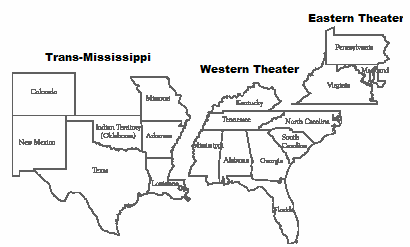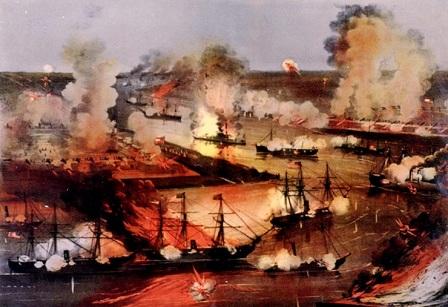| Short Summary of the Battle of New Orleans
Short Summary: Union forces were seeking to capture the city during the American Civil War. The naval Battle of New Orleans around St. Bernard Parish, Louisiana was fought on April 24, 1862 to May 1, 1862. The Union warships were led by Admiral David G. Farragut and Commander Benjamin Butler. The Confederate naval forces and the command of Fort Jackson & Fort St. Philip were led by Major General Mansfield Lovell. The capture of New Orleans was a great victory for the Union, which gained the North military, tactical, economic and political control of the of the lower Mississippi River. Civil War Battle of New Orleans
Abraham Lincoln was the 16th American President who served in office from March 4, 1861 to April 15, 1865. One of the major battlefields in the Civil War during his presidency was the Naval Battle of New Orleans, often referred to as the Capture of New Orleans. |
|
| Facts about the Civil War Battle of New Orleans
The main battles of the Civil War were divided into two principal theaters in which the major military operations took place. The Battle of New Orleans was fought in New Orleans in the Western theater. Facts about the Civil War Battle of New Orleans
The Civil War Battle Union forces wanted to capture the city during the American Civil War because it held one of the keys to controlling of the lower Mississippi River, an important waterway for carrying goods and supplies. | Civil War Battlegrounds |
Facts about the Civil War Battle of New Orleans: Importance off New Orleans
The plan of the North was to enter the mouth of the Mississippi River, ascend to New Orleans, capture the city and close off the mouth of the Mississippi to Confederate ships. The capture of New Orleans was part of the Anaconda Plan, the military strategy to impose a Union Blockade of the South. This Confederate held area gave the South access to Texas, and through Texas to Mexico. The Union blockade were succeeding in blocking access in important Southern ports. As long as the Confederacy could continue to maintain trade and commerce overland with Mexico, the South could continue their fight and continue bringing in money from their cotton trade. The tactical importance of the Mississippi was due to the very size of the river and its numerous mouths and estuaries that made it possible for vessels to deliver and collect supplies. Access to the trading port of New Orleans and control of the lower Mississippi River was therefore critical to both the North and the South. Facts about the Civil War Battle of New Orleans: The Capture of New Orleans
The leaders of the Union forces were determined to capture Confederate New Orleans and the lower Mississippi. The command of the naval expedition was given to Admiral David Glasgow Farragut (1801 – 1870) but his naval fleet was blocked by the cannon fire of Fort Jackson & Fort St. Philip. The Confederates had also supplemented the defense of the forts around the city by two defensive barrier chains that were stretched right across the river as a barrier to slow down, the passage of enemy vessels. As enemy vessels were forced to slow down they would be open to Confederate fire from Fort Jackson & Fort St. Philip. Battle and Capture of New Orleans 
| Capture of New Orleans: The Forts
Fort St. Philip and Fort Jackson were two closely associated forts on the Mississippi River with a total of 177 guns. Fort Jackson and Fort St. Philip were under the local command of Brigadier General Johnson K. Duncan. Capture of New Orleans: Forts St. Philip and Jackson
In the picture Fort St. Phillip is shown on the right and Fort Jackson on the left, located on a bend in the Mississippi River designed to slow enemy ships still further. Fort St. Phillip is shown at right and Fort Jackson at left. The Capture of New Orleans: The Fleets
The Confederate fleet consisted of three new Ironclad Warships, 10 gunboats and an assortment of other smaller vessels. The Confederates also made good use of fire rafts (see lower right in the picture). The Union fleet consisted of 43 ships including 17 gunships and 19 mortar boats (naval vessels that carried 13-inch mortars). |
Facts about the Civil War Battle of New Orleans: Breaking the Chains and the Capture of New Orleans
The Union naval squadron of 43 ships, under the command of Admiral Farragut, entered the lower Mississippi near New Orleans on April 24, 1862. Admiral Farragut soon realized that he had to breach the heavy chain cables that were stretched across the river as a prime Confederate defense of New Orleans. Farragut ordered three of his gunboats, the Kineo, Itasca, and Pinola, to break the chain barrier that was blocking the river. The gunboats did not succeed in removing the chain barrier altogether, but they were able to open a gap large enough for the Union naval fleet to get through the Confederate defense system. Facts about the Civil War Battle of New Orleans: The Capture of New Orleans
Despite the ferocious opposition from Confederate cannon, the warships and the mighty Ironclads, Admiral Farragut and the Union fleet succeeded in passing the forts. Realizing that further resistance by his tiny force would be futile and to save his soldiers for further battles, Confederate General Mansfield Lovell withdrew his 3,000 troops northward and New Orleans was forced to surrender on April 25, 1862. On May 1, 1862 General B.F. Butler led 15,000 Union troops into New Orleans to take command of the city for the remainder of the Civil War. Facts about the Civil War Battle of New Orleans
The following short fact sheet provides interesting facts and information about the Battle of New Orleans, one of the major battles that was fought during the American Civil War (April 12, 1861 and continued until May 10, 1865). |
Civil War Battle of New Orleans: FAQ's (Frequently Asked Questions for kids) | | Facts for Kids | Questions and Answers | | Battle of New Orleans Fact 1 | Q. Where was the Battle of New Orleans fought?
A. It was fought in New Orleans and St. Bernard Parish, Louisiana | | | | Battle of New Orleans Fact 2 | Q. When was the Battle of New Orleans fought?
The Battle of New Orleans was fought between April 24, 1862 to May 1, 1862 and resulted in the capture of the city | | | | Battle of New Orleans Fact 3 | Q. Who won the Battle of New Orleans?
A. The battle of New Orleans was won by the Union | | | | Battle of New Orleans Fact 4 | Q. Who were the generals and leaders?
A. The Confederate general was Major General Mansfield Lovell. The Union Generals at the Battle of New Orleans were Admiral David G. Farragut and Commander Benjamin Butler | | | | Battle of New Orleans Fact 5 | Q. How many men fought for the capture of the city in the Battle of New Orleans?
A. The strength of the Union force at the Battle of New Orleans was 15,000. The number of Confederate soldiers totaled 3,000. | Civil War Battle of New Orleans: FAQ's (Frequently Asked Questions for kids) |
Civil War Battle of New Orleans
The info about the Civil War naval Battle of New Orleans provides interesting facts and important information about this important Civil War conflict that occured during the presidency of the 16th President of the United States of America. |
Civil War Battle of New Orleans: FAQ's (Frequently Asked Questions for kids) | | Facts for Kids | Questions and Answers | | Battle of New Orleans Fact 6 | Q. What was the significance of the Capture of New Orleans?
The capture and permanent loss of the New Orleans was considered one of the worst disasters suffered by the Confederacy in the western theater of the Civil War. | | | | Battle of New Orleans Fact 7 | Q. Why was the Battle of New Orleans important?
A. It was strategically significant because the Confederacy lost control of the lower Mississippi River and the important trading port of New Orleans. | | | | Battle of New Orleans Fact 8 | David Farragut had been selected by the Union government for the command of the West Gulf Blockading Squadron in January 1862 | | | | Battle of New Orleans Fact 9 | The Confederate fleet inflicted little harm to the Union flotilla, and most of them were sunk. The cannon fire from the forts was poorly aimed and once again the Confederates failed to inflict much harm on the Union Naval force | | | | Battle of New Orleans Fact 10 | The people of New Orleans were Panic-stricken when the soldiers withdrew, no defense was possible. People broke into stores, burned cotton and other supplies, and destroyed much of the waterfront of the city. | | | | Battle of New Orleans Fact 11 | Following the capture of New Orleans Admiral Farragut demanded the surrender of other cities on the Mississippi River. Baton Rouge and Natchez, left defenseless were forced to comply. | | | | Battle of New Orleans Fact 12 | Vicksburg was another matter, as the guns of the ships could not reach the Confederate fortifications on top of the high cliffs. The Siege of Vicksburg was eventually fought a year later from May 18, 1863 to July 4, 1863. | | | | Battle of New Orleans Fact 13 | The Union occupation of New Orleans was an event that had major international significance. The Capture of New Orleans was a serious political blow to the Confederacy and contributed to the lack of formal support from the powers in Europe, who were primarily concerned with backing the side that could send them cotton. | | | | Battle of New Orleans Fact 14 | The large free black community of the City of New Orleans went on to provide several regiments for the Union armies | Civil War Battle of New Orleans: FAQ's (Frequently Asked Questions for kids) |
Civil War Battle of New Orleans - President Abraham Lincoln Video
The article on the Battle of New Orleans provides an overview of one of the major events of his presidential term in office. The following Abraham Lincoln video will give you additional important facts and dates about the political events experienced by the 16th American President whose presidency spanned from March 4, 1861 to April 15, 1865. | | |
| |
|